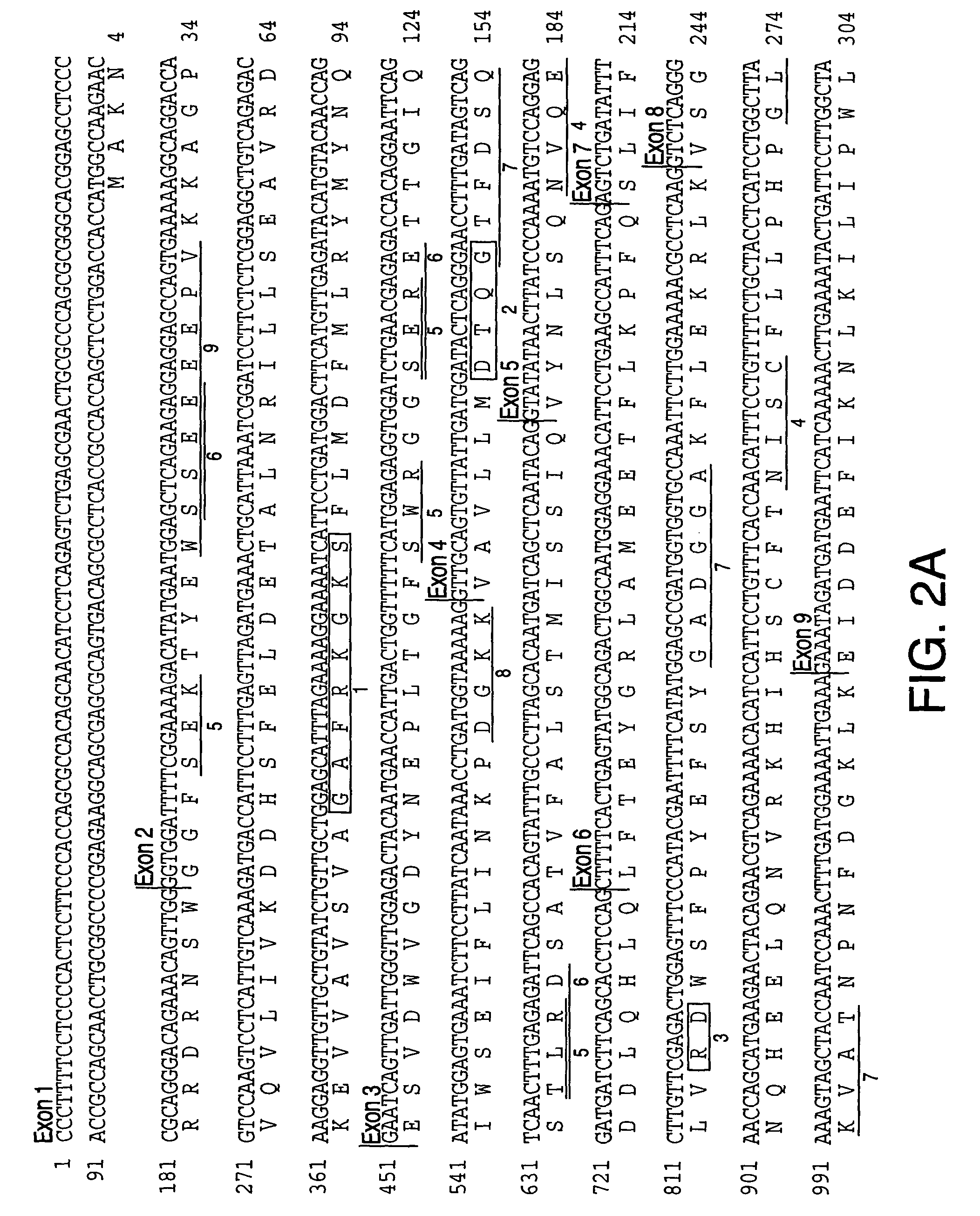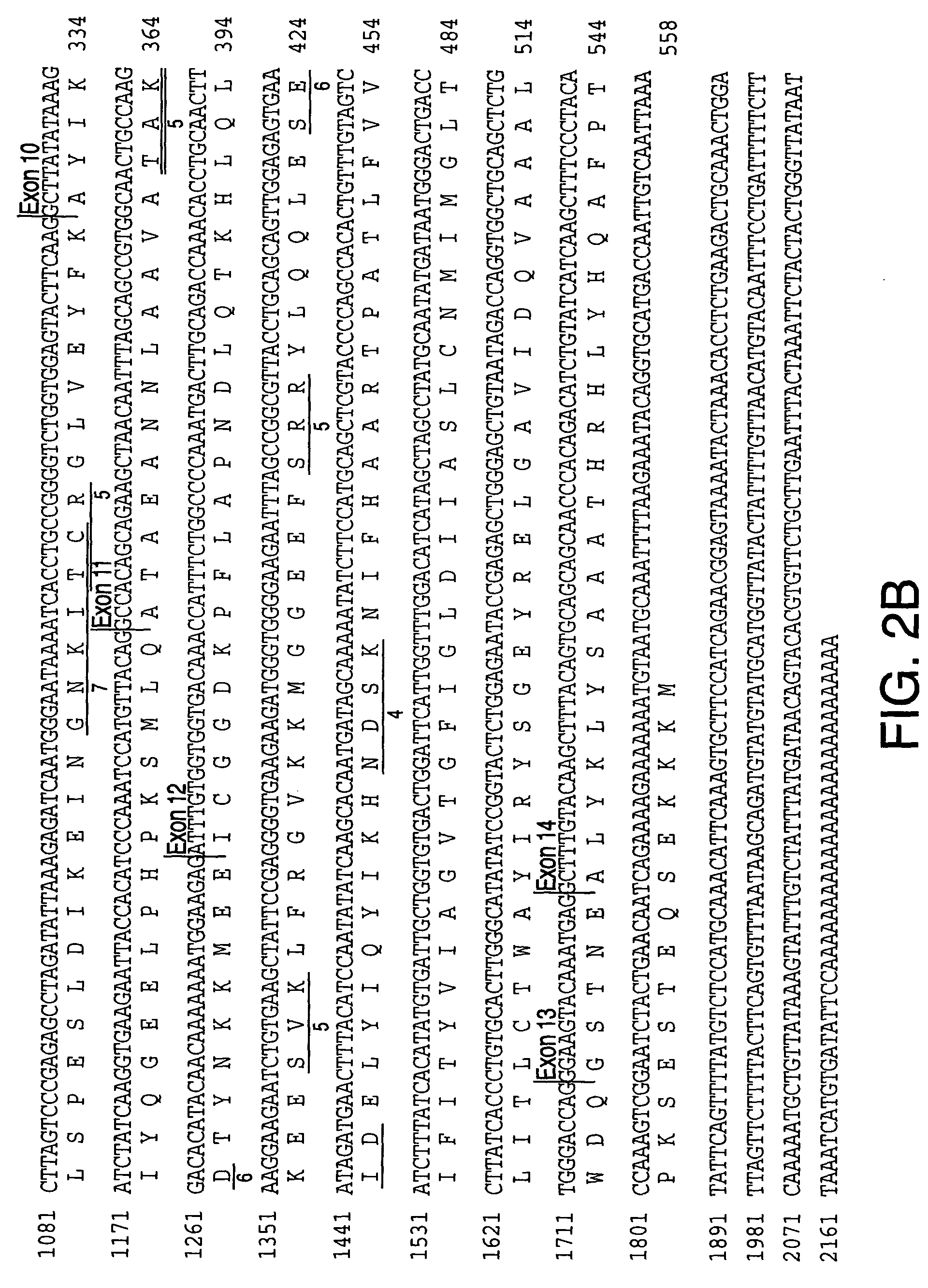Atlastin
a technology of atlastin and gene, applied in the field of atlastin, can solve problems such as complete loss of lower limb mobility
- Summary
- Abstract
- Description
- Claims
- Application Information
AI Technical Summary
Benefits of technology
Problems solved by technology
Method used
Image
Examples
example 1
[0347]Genetic linkage analysis. This example shows how individuals were selected and how genetic analysis was performed. Three autosomal dominant HSP kindreds were evaluated. HSP was diagnosed according to published criteria (Fink, et al., 1996). Each affected subject had symptom onset before age 10 years (usually before age 5). Prenatal diagnosis of HSP and skeletal muscle biopsy in ADHSP-T kindred have been reported previously for these individuals. Samples were obtained from 111 control subjects who were older than age 60, examined by a team of Neurology and Psychiatry resident physicians, and had completed the Screening Criteria of Informative Diagnoses. This study and the process of informed consent were approved by the University of Michigan Institutional Review Board.
[0348]DNA was extracted from peripheral blood leukocytes, microsatellite DNA polymorphisms analyzed, and two-point lodscores were calculated. For genetic linkage analysis, we used an autosomal dominant monogenic ...
example 2
[0352]Identification of SPG3 candidate genes. DNA sequences of the Genoscope contig and the NCBI contigs spanning the SGP3 locus (D14S259 to D14S978) are available in publicly accessible databases (The National Center for Biological Information and Genescope [sposored by The French Ministery of Education, Research and Technology (MENRT); The French Agency of Scientific Research (CNRS) and The French Scientific Innovation and Transfer Company (FIST)]). Some ESTs and cDNA sequences were listed with each annotated NCBI contig; others were identified by analysis of these contig DNA sequences with GENESCAN and GRAIL programs of the PIPELINE suite of programs (from the Computational Biology Section of the Life Sciences Division of Oak Ridge National Laboratory, Oak Ridge, Tenn.). Potential exonic sequences and candidate genes identified in this manner were compared through BLAST analysis to sequences in public databases (The National Center for Biological Information, Genbank and The Nati...
example 3
[0354]Sequencing of SPG3 candidate genes. Initial analysis of candidate genes for disease-specific mutations was performed in gDNA samples from three affected and one unaffected subject from ADHSP-P kindred. Following the discovery of atlastin gene mutations in affected subjects in this initial test cohort, we analyzed gDNA samples from each available subject from this kindred and from ADHSP-T and ADHSP-S kindreds and 111 control subjects. 50 ng of DNA was used in PCR amplification of each candidate gene exon (see Table 1).
[0355]PCR products were purified through Sephadex G-50 columns and analyzed by agarose gel electrophoresis before cycle sequencing. Purified PCR products were sequenced with one of the PCR primers according to the manufacturer's instruction using the ABI PRISM dRhodamine Terminator Cycle Sequencing Ready Reaction Kit (PE Applied Biosystems, USA) on an ABI PRISM 3100 Genetic Analyzer. Both strands of each exon were sequenced. Sequence data was analyzed with SeqMan ...
PUM
| Property | Measurement | Unit |
|---|---|---|
| pH | aaaaa | aaaaa |
| temperatures | aaaaa | aaaaa |
| diameter | aaaaa | aaaaa |
Abstract
Description
Claims
Application Information
 Login to View More
Login to View More - R&D
- Intellectual Property
- Life Sciences
- Materials
- Tech Scout
- Unparalleled Data Quality
- Higher Quality Content
- 60% Fewer Hallucinations
Browse by: Latest US Patents, China's latest patents, Technical Efficacy Thesaurus, Application Domain, Technology Topic, Popular Technical Reports.
© 2025 PatSnap. All rights reserved.Legal|Privacy policy|Modern Slavery Act Transparency Statement|Sitemap|About US| Contact US: help@patsnap.com



